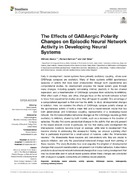Use este identificador para citar ou linkar para este item:
https://repositorio.ufrn.br/handle/123456789/23982Registro completo de metadados
| Campo DC | Valor | Idioma |
|---|---|---|
| dc.contributor.author | Blanco, Wilfredo | - |
| dc.contributor.author | Bertram, Richardson | - |
| dc.contributor.author | Tabak, Joel | - |
| dc.date.accessioned | 2017-09-29T16:09:57Z | - |
| dc.date.available | 2017-09-29T16:09:57Z | - |
| dc.date.issued | 2017-09-29 | - |
| dc.identifier.citation | Blanco W, Bertram R and Tabak J (2017) The Effects of GABAergic Polarity Changes on Episodic Neural Network Activity in Developing Neural Systems. Front. Comput. Neurosci. 11:88. doi: 10.3389/fncom.2017.00088 | pt_BR |
| dc.identifier.uri | https://repositorio.ufrn.br/jspui/handle/123456789/23982 | - |
| dc.language | eng | pt_BR |
| dc.rights | Acesso Aberto | pt_BR |
| dc.subject | developing neural networks | pt_BR |
| dc.subject | balance | pt_BR |
| dc.subject | activity episodes | pt_BR |
| dc.subject | excitatory-inhibitory | pt_BR |
| dc.subject | heterogeneity | pt_BR |
| dc.subject | GABAergic neurons | pt_BR |
| dc.title | The Effects of GABAergic Polarity Changes on Episodic Neural Network Activity in Developing Neural Systems | pt_BR |
| dc.type | article | pt_BR |
| dc.identifier.doi | doi: 10.3389/fncom.2017.00088 | - |
| dc.description.resumo | Early in development, neural systems have primarily excitatory coupling, where even GABAergic synapses are excitatory. Many of these systems exhibit spontaneous episodes of activity that have been characterized through both experimental and computational studies. As development progress the neural system goes through many changes, including synaptic remodeling, intrinsic plasticity in the ion channel expression, and a transformation of GABAergic synapses from excitatory to inhibitory. What effect each of these, and other, changes have on the network behavior is hard to know from experimental studies since they all happen in parallel. One advantage of a computational approach is that one has the ability to study developmental changes in isolation. Here, we examine the effects of GABAergic synapse polarity change on the spontaneous activity of both a mean field and a neural network model that has both glutamatergic and GABAergic coupling, representative of a developing neural network. We find some intuitive behavioral changes as the GABAergic neurons go from excitatory to inhibitory, shared by both models, such as a decrease in the duration of episodes. We also find some paradoxical changes in the activity that are only present in the neural network model. In particular, we find that during early development the inter-episode durations become longer on average, while later in development they become shorter. In addressing this unexpected finding, we uncover a priming effect that is particularly important for a small subset of neurons, called the “intermediate neurons.” We characterize these neurons and demonstrate why they are crucial to episode initiation, and why the paradoxical behavioral change result from priming of these neurons. The study illustrates how even arguably the simplest of developmental changes that occurs in neural systems can present non-intuitive behaviors. It also makes predictions about neural network behavioral changes that occur during development that may be observable even in actual neural systems where these changes are convoluted with changes in synaptic connectivity and intrinsic neural plasticity. | pt_BR |
| Aparece nas coleções: | ICe - Artigos publicados em periódicos | |
Arquivos associados a este item:
| Arquivo | Descrição | Tamanho | Formato | |
|---|---|---|---|---|
| WilfredoBlanco_ICe_2017_TeheffectsofGABA.pdf | 4,09 MB | Adobe PDF |  Visualizar/Abrir |
Os itens no repositório estão protegidos por copyright, com todos os direitos reservados, salvo quando é indicado o contrário.

